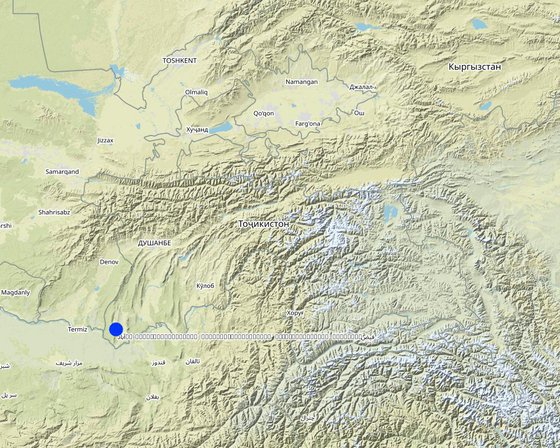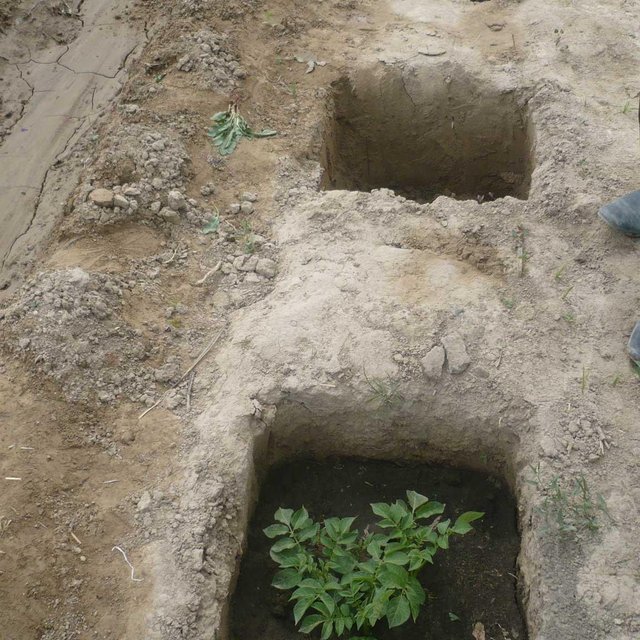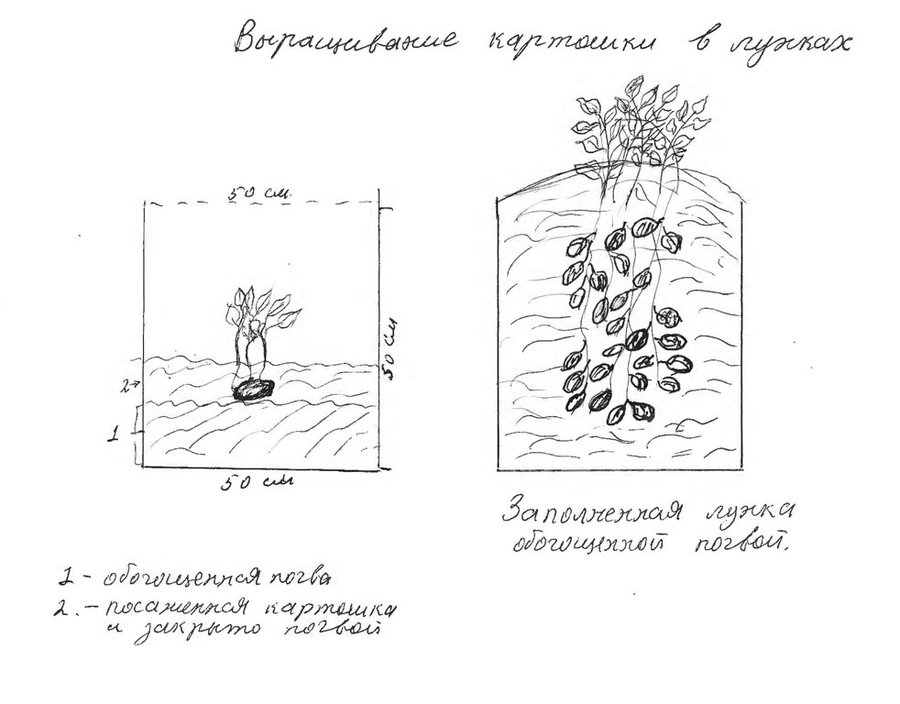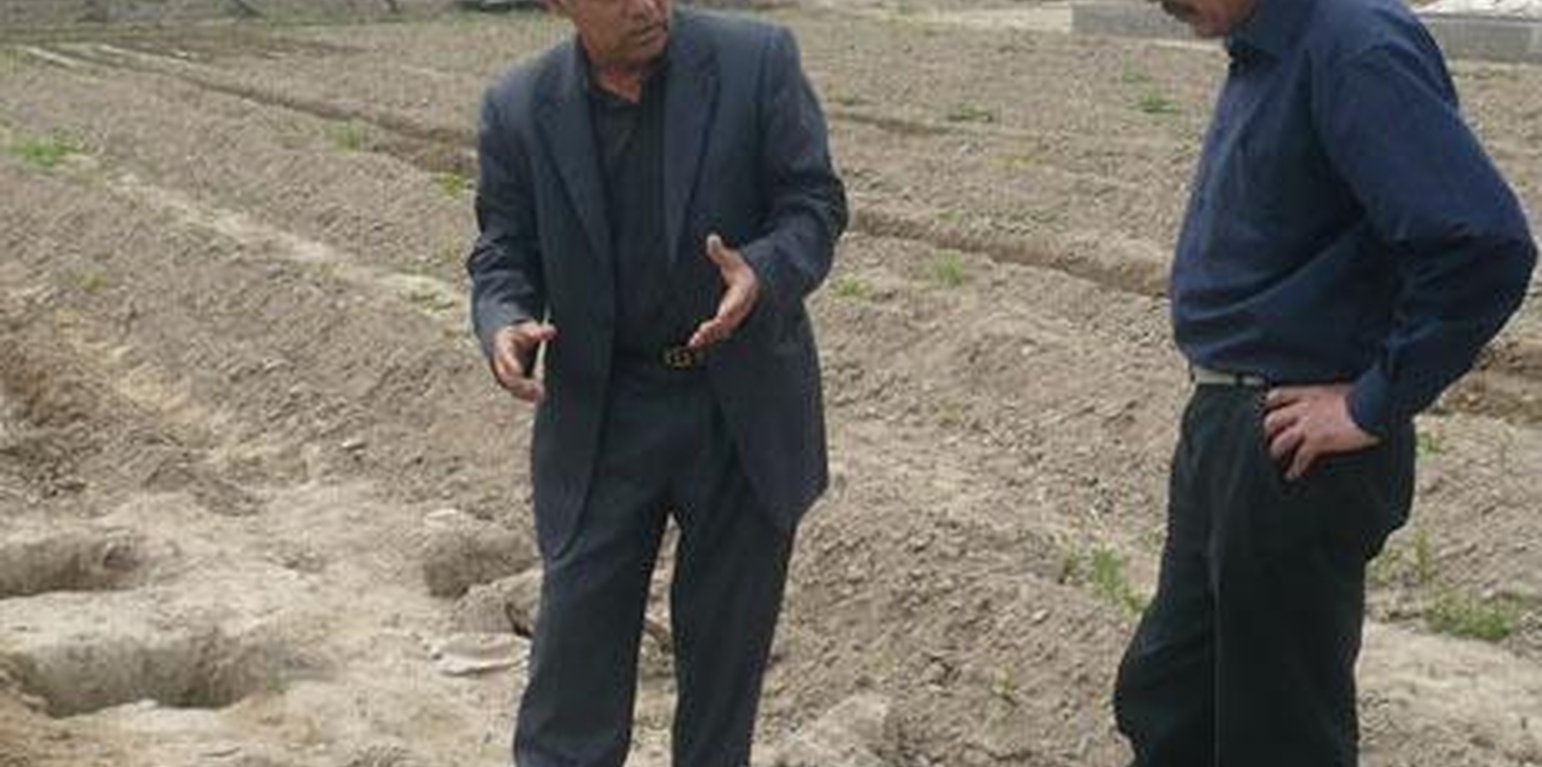Выращивание картофеля в лунке
(Tajikistan)
Description
Технология выращивание картошки в лунке
Это технология используется для получения продукции в зонах дефицита воды и экстремальных условиях. Технология очень проста: капают яму размером 50 х 50 х50 см. на дно ямы засыпают компост или обогащенную почву, и сажают одну или две семенные картошки. По мере роста ботва закапывается, полив осуществляется регулярно.
Цель технологии: улучшение производства картофеля, и тем самым, повышение дохода фермера в таких климатических условиях. Технология показывает хорошие адаптационные возможности в засушливых районах. Метод улучшает доступ к воде.
Основные действия и вложения: Технология очень простая и не требует больших затрат. Основным вкладом для фермеров является приготовление компоста и покупка высококачественных семян. Физическая работа требуется для приготовления ямы и для дальнейшего ухода за картофелем.
Природная\социальная обстановка: Данная технология может быть внедрена, как и в дехканских фермах, так и в приусадебных участках
Location

Location: Хатлонский район, Н.Хусравский район, Таджикистан, Tajikistan
No. of Technology sites analysed:
Geo-reference of selected sites
Spread of the Technology: evenly spread over an area (approx. < 0.1 km2 (10 ha))
In a permanently protected area?:
Date of implementation:
Type of introduction
-
through land users' innovation
-
as part of a traditional system (> 50 years)
-
during experiments/ research
-
through projects/ external interventions

Яма, где выращивается картофель (Каландаров Р. (г.Душанбе. ул.Герцина 3.))
Classification of the Technology
Main purpose
-
improve production
-
reduce, prevent, restore land degradation
-
conserve ecosystem
-
protect a watershed/ downstream areas – in combination with other Technologies
-
preserve/ improve biodiversity
-
reduce risk of disasters
-
adapt to climate change/ extremes and its impacts
-
mitigate climate change and its impacts
-
create beneficial economic impact
-
create beneficial social impact
Land use
-
Cropland
- Annual cropping: root/tuber crops - potatoes
Number of growing seasons per year: 2
Water supply
-
rainfed
-
mixed rainfed-irrigated
-
full irrigation
Purpose related to land degradation
-
prevent land degradation
-
reduce land degradation
-
restore/ rehabilitate severely degraded land
-
adapt to land degradation
-
not applicable
Degradation addressed
-
chemical soil deterioration - Cn: fertility decline and reduced organic matter content (not caused by erosion)
-
physical soil deterioration - Pk: slaking and crusting, Pi: soil sealing
SLM group
-
irrigation management (incl. water supply, drainage)
SLM measures
-
agronomic measures - A2: Organic matter/ soil fertility, A6: Residue management
Technical drawing
Technical specifications
Схема показывает нижнею часть ямы заполняемую компостом и почвой по мера роста побегов Постепенно до поверхности лунка засыпается обогащенной почвой.
Место расположения: Юг Таджикистана. Н.Хусравский Район, Хатлонская область
Дата: 11.05.2011
Необходимые технические навыки для землепользователей: средний
Основные технические функции: улучшение поверхностной структуры (покрытие коркой, уплотнение)
Выращивание в грядках
Материал: семена картошки
Пояснение: лункование
Навоз / компост / остатки
Материал: компост

Author: Каландаров Р., г.Душанбе. ул.Герцина 3.
Establishment and maintenance: activities, inputs and costs
Calculation of inputs and costs
- Costs are calculated:
- Currency used for cost calculation: USD
- Exchange rate (to USD): 1 USD = n.a 450
- Average wage cost of hired labour per day: n.a
Most important factors affecting the costs
основной фактор - копка лунки
Establishment activities
-
Копание лунок (Timing/ frequency: None)
Establishment inputs and costs
| Specify input |
Unit |
Quantity |
Costs per Unit (USD) |
Total costs per input (USD) |
% of costs borne by land users |
|
Labour
|
| Копание лунок |
га |
1.0 |
8.0 |
8.0 |
100.0 |
|
Equipment
|
| Инструменты |
шт |
1.0 |
5.0 |
5.0 |
100.0 |
|
Plant material
|
| семена |
кг |
200.0 |
0.45 |
90.0 |
1.0 |
| Total costs for establishment of the Technology |
103.0 |
|
| Total costs for establishment of the Technology in USD |
103.0 |
|
Maintenance activities
-
копка ям (Timing/ frequency: человек ден)
-
заполнение лунок почвой (Timing/ frequency: человек/день)
Maintenance inputs and costs
| Specify input |
Unit |
Quantity |
Costs per Unit (USD) |
Total costs per input (USD) |
% of costs borne by land users |
|
Labour
|
| заполнение лунок почвой |
человек/день |
0.1 |
5.0 |
0.5 |
100.0 |
| Total costs for maintenance of the Technology |
0.5 |
|
| Total costs for maintenance of the Technology in USD |
0.5 |
|
Natural environment
Average annual rainfall
-
< 250 mm
-
251-500 mm
-
501-750 mm
-
751-1,000 mm
-
1,001-1,500 mm
-
1,501-2,000 mm
-
2,001-3,000 mm
-
3,001-4,000 mm
-
> 4,000 mm
Agro-climatic zone
-
humid
-
sub-humid
-
semi-arid
-
arid
Specifications on climate
Термический класс климата: субтропический
Slope
-
flat (0-2%)
-
gentle (3-5%)
-
moderate (6-10%)
-
rolling (11-15%)
-
hilly (16-30%)
-
steep (31-60%)
-
very steep (>60%)
Landforms
-
plateau/plains
-
ridges
-
mountain slopes
-
hill slopes
-
footslopes
-
valley floors
Altitude
-
0-100 m a.s.l.
-
101-500 m a.s.l.
-
501-1,000 m a.s.l.
-
1,001-1,500 m a.s.l.
-
1,501-2,000 m a.s.l.
-
2,001-2,500 m a.s.l.
-
2,501-3,000 m a.s.l.
-
3,001-4,000 m a.s.l.
-
> 4,000 m a.s.l.
Technology is applied in
-
convex situations
-
concave situations
-
not relevant
Soil depth
-
very shallow (0-20 cm)
-
shallow (21-50 cm)
-
moderately deep (51-80 cm)
-
deep (81-120 cm)
-
very deep (> 120 cm)
Soil texture (topsoil)
-
coarse/ light (sandy)
-
medium (loamy, silty)
-
fine/ heavy (clay)
Soil texture (> 20 cm below surface)
-
coarse/ light (sandy)
-
medium (loamy, silty)
-
fine/ heavy (clay)
Topsoil organic matter content
-
high (>3%)
-
medium (1-3%)
-
low (<1%)
Groundwater table
-
on surface
-
< 5 m
-
5-50 m
-
> 50 m
Availability of surface water
-
excess
-
good
-
medium
-
poor/ none
Water quality (untreated)
-
good drinking water
-
poor drinking water (treatment required)
-
for agricultural use only (irrigation)
-
unusable
Water quality refers to:
Is salinity a problem?
Occurrence of flooding
Characteristics of land users applying the Technology
Market orientation
-
subsistence (self-supply)
-
mixed (subsistence/ commercial)
-
commercial/ market
Off-farm income
-
less than 10% of all income
-
10-50% of all income
-
> 50% of all income
Relative level of wealth
-
very poor
-
poor
-
average
-
rich
-
very rich
Level of mechanization
-
manual work
-
animal traction
-
mechanized/ motorized
Sedentary or nomadic
-
Sedentary
-
Semi-nomadic
-
Nomadic
Individuals or groups
-
individual/ household
-
groups/ community
-
cooperative
-
employee (company, government)
Age
-
children
-
youth
-
middle-aged
-
elderly
Area used per household
-
< 0.5 ha
-
0.5-1 ha
-
1-2 ha
-
2-5 ha
-
5-15 ha
-
15-50 ha
-
50-100 ha
-
100-500 ha
-
500-1,000 ha
-
1,000-10,000 ha
-
> 10,000 ha
Scale
-
small-scale
-
medium-scale
-
large-scale
Land ownership
-
state
-
company
-
communal/ village
-
group
-
individual, not titled
-
individual, titled
Land use rights
-
open access (unorganized)
-
communal (organized)
-
leased
-
individual
Water use rights
-
open access (unorganized)
-
communal (organized)
-
leased
-
individual
Access to services and infrastructure
employment (e.g. off-farm)
drinking water and sanitation
Impacts
Socio-economic impacts
demand for irrigation water
Socio-cultural impacts
food security/ self-sufficiency
Cost-benefit analysis
Benefits compared with establishment costs
Short-term returns
very negative
very positive
Benefits compared with maintenance costs
Short-term returns
very negative
very positive
Climate change
Gradual climate change
annual temperature increase
not well at all
very well
Climate-related extremes (disasters)
not well at all
very well
not well at all
very well
not well at all
very well
not well at all
very well
Other climate-related consequences
not well at all
very well
Adoption and adaptation
Percentage of land users in the area who have adopted the Technology
-
single cases/ experimental
-
1-10%
-
11-50%
-
> 50%
Of all those who have adopted the Technology, how many have done so without receiving material incentives?
-
0-10%
-
11-50%
-
51-90%
-
91-100%
Has the Technology been modified recently to adapt to changing conditions?
To which changing conditions?
-
climatic change/ extremes
-
changing markets
-
labour availability (e.g. due to migration)
Conclusions and lessons learnt
Strengths: land user's view
Strengths: compiler’s or other key resource person’s view
-
Технология новая
Как можно сохранять устойчивость или усилить? по мере возможности
-
при выращивании в лунках урожайность повышается
Как можно сохранять устойчивость или усилить? при соблюдении агротехники можно получить хороший урожай
-
водосберегательная технология
Как можно сохранять устойчивость или усилить? полив воды производиться индивидуально
-
технологию можно использовать даже на небольших земельных участках (на приусадебных участках)
Как можно сохранять устойчивость или усилить? при использовании этой технологии, можно обеспечить картофелем одну семью
Weaknesses/ disadvantages/ risks: land user's viewhow to overcome
Weaknesses/ disadvantages/ risks: compiler’s or other key resource person’s viewhow to overcome
-
технология применима только на малых участках
-
None
References
Reviewer
-
Alexandra Gavilano
-
David Streiff
-
Joana Eichenberger
Date of documentation: Mei 4, 2011
Last update: Nov. 2, 2021
Resource persons
-
Rustam Kalandarov - SLM specialist
-
Sa'dy Odinashoev - SLM specialist
Full description in the WOCAT database
Documentation was faciliated by
Institution
- NCCR North-South (NCCR North-South) - Kyrgyzstan
- Youth Ecological Center, Tajikistan (Youth Ecological Center, Tajikistan) - Tajikistan
Project
- Pilot Program for Climate Resilience, Tajikistan (WB / PPCR)










